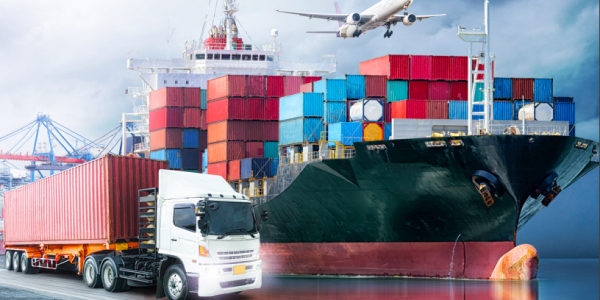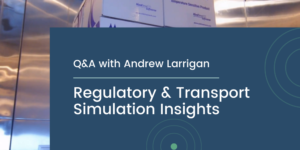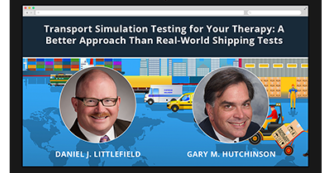Simulated Transport Methodologies
Learn how our real-time transport simulation approach is the most reliable way to test...
read Details

We sat down with Andrew Larrigan, Technical Operations Manager, to dive into his insights on Modality Solutions’ expertise, value, and various pitfalls often encountered by clients before they ask Modality for help.
Andrew: It all comes down to patient safety, which is what we’re helping to ensure with all our consulting and testing work. Through our programs, the drug product’s dossier has a better foundation and offers more to the patient through more reliable stability and shipping preparation. Even though the value there is hard to quantify, all the work we have done has helped save and better so many people’s lives.
Andrew: Usually internal expertise on cold chain management or testing capabilities. Often, smaller companies will have smaller teams tasked with shipping validation, or they might have staff that multitask. This is a risk because they usually don’t have the depth of knowledge and cold chain experience that we do, and they might not maintain their training on ongoing regulatory changes. In addition, most companies don’t have the appropriate equipment to test variables experienced during cold chain distribution, so any internal attempts at shipping validation can be difficult. That’s why we focus on the 5 shipping hazards – temperature, pressure, humidity, shock and vibration, and we have a simulation lab specifically designed to concurrently test these variables.
Andrew: A lot of times they may hire external package testing labs that are not as well suited as our lab, or they will internally execute their protocol – which might be poorly designed. A lot of it comes down to problems with the design of the studies.
We understand the regulatory expectations and track shifts in the industry for these types of transport simulations, and we know what questions regulators may ask and what they expect to see. Within pharma, this focused expertise is usually lacking in a package testing lab, leading to headaches when it comes to regulatory approval.
> DOWNLOAD: Simulated Transport Methodologies from Modality Solutions
Andrew: My main role in the company is managing our transport simulation lab here in Bloomington, Indiana. That involves managing and overseeing all the studies and the team we have here in Indianapolis and Bloomington. It’s the day-to-day operations and execution of the studies.
In addition, as an added value to the customer, we design many of the study protocols, so our teams are writing the protocols and the subsequent reports.
Andrew: We really focus on the purpose of each study and what data they must collect, whether it’s a product-focused study or a packaging-focused study, and what we’re looking to characterize. We have a lot of good internal templates that we’ve used for our clients—studies that have been reviewed by regulators all over the world with a 100% success rate.
And so, we already have those templates for your study ready to go. That means we can spend the time upfront understanding what you need and then properly designing it to be applicable for your product or packaging system. This is a value-added service for our customers, which ends up saving time as well.
Andrew: Our transport simulation lab is unique. We believe it’s the only for-hire transport simulation lab with the concurrent ability to test all five transport hazards: temperature, humidity, shock, vibration, and pressure.
So, in the thermal chamber, we use temperature ranges from -35° to 60° Celsius. For any products that require lower temperature specs, we use dry ice and liquid nitrogen as the thermal source. So, we are truly able to test any temperature that is possible for products within the supply chain.
For shock testing, we do pallet and parcel-level drop testing from different heights, different orientations. For vibration, we have a pretty large vibration table that’s about 25 sq. ft.
We also can do double-stack pallet testing all the way down to just a single box. And that’s all located within the thermal chamber for concurrent hazard simulation. We’re able to test high altitude/low pressure for high truck travel, as well as air modes of transport and any other low pressures the product could see in the supply chain.
Andrew: I’d say mostly it’s the combination of parameters. But the uniqueness of how we do vibration testing is probably the most surprising, and it’s also the biggest hurdle when trying to show the client our testing strategy. And that’s because for product focus studies, we’ll do non-accelerated vibration testing.
Typical package studies with accelerated vibration profiles will have three to four hours of accelerated vibration. When we do non-accelerated real-time-duration vibration studies, the move time in a supply chain may be 80 hours (or more) compared to a three-hour accelerated vibration study in a package test lab. That’s probably the biggest difference. Especially when we’re talking about biologics.
> CASE STUDY: Transport Validation Helps Ensure Drug Stability for Ocean Container Shipments
Andrew: Plunger movement studies are very important for pre-filled syringe presentations. What we do is characterize the amount of plunger movement that prefilled syringes will see during low pressure exposures. We’ll run it through multiple low-pressure cycles to ensure this activity does not translate to extensive plunger movement as you ship it around the world.
We have methodologies developed internally to characterize the length of movement that you’ll see during low pressure exposures. And we’ll compare that to the geometry of the plunger (for the predefined acceptance criteria) and be able to determine if the plunger movement observed is acceptable. It all comes down to control of the bubble size during manufacturing. The smaller the bubble, the less air there is to expand and move the plunger.
At a certain point, extensive plunger movement could mean the product coming in contact with the unsterile portion of the barrel. So, we’re characterizing it to ensure that it stays under that limit. If not, then their manufacturer might be asked to control the bubble size better.
Andrew: There are a lot of ASTM standards, the first step would be identifying the ones to keep up with. ASTM provides tools so you can subscribe to updates and be notified about planned or new changes to the standards.
As a company, Modality Solutions has voting memberships for the packaging group within ASTM, which means we can contribute to decisions on new or updated package testing standards and actually vote and provide guidance to ASTM.
Andrew: Many times, we need to explain the difference between our strategy for product focused studies, and how that differs significantly from accelerated vibration package testing.
And that’s kind of the biggest hurdle we have for explaining—they may understand the ASTM standards, or they may just know of some of the package testing standards. A lot of people are used to those types of studies so when we do concurrent testing in a non-accelerated fashion, it’s a lot different. We’re referencing multiple things rather than a single standard for testing.
Andrew: I just like to drive home our purpose and what we’re doing to keep patients safe and help clients get their products to market so they can improve people’s lives. Saving and improving people’s lives is really what it all comes down to.
For more information about our team’s expertise, our transport simulation lab, or the current regulatory landscape, fill out the form below.
Learn how our real-time transport simulation approach is the most reliable way to test...
read Details
Examines the effectiveness of simulated transport studies. This new study uses a holistic form...
read Details
Modality Solutions has access to the latest regulatory agency requirements for emerging new therapies....
read Details